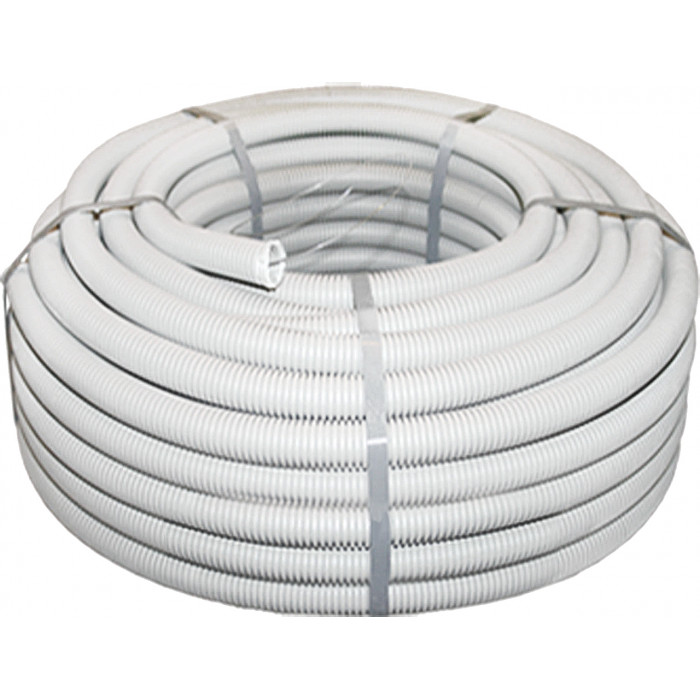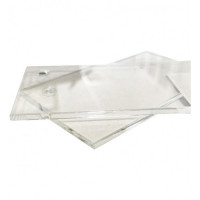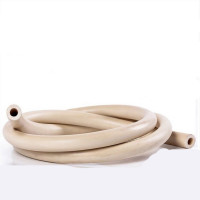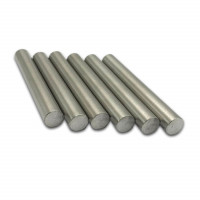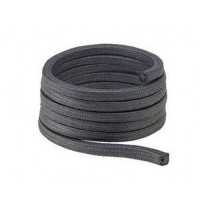Pipe for electrical wiring flexible corrugated without broach diameter 25 mm
PVC, lightweight, flame retardant, no pull, gray
Main characteristics
Outer Diameter:32mm
Inner Diameter:24.9mm
Presence of broach: No
Degree of protection: IP55
Color: gray
Material:PVC (PVC)
Performance characteristics
Operating temperature: -25 °C ... +60 °C
Mounting temperature: -5 °С ... +60 °С
Minimum bending radius: 96 mm
Strength (resistance to compression at 20 °C): over 350 N per 5 cm
Tensile strength: not less than 100 N
Impact strength:> 0.5 J at -25 ° C
Electrical corrugation is a flexible plastic pipe, corrugated along the length. The corrugation does not support combustion, and have increased strength to ensure the replacement of electrical wiring.
It is possible to lay electric cables up to 1000V in the corrugation, as well as telephone cables, cables of computer and television networks.
Corrugation reliably protects wiring in fireproof structures, in walls, floors and ceilings. It does not interact with mortars, therefore it perfectly hides in the furrows with plaster.
It is recommended to use each corrugation sleeve for only one group of electrical wiring. For ease of installation, a wire rod is laid in the electrical corrugation, it helps to quickly tighten the cable into the corrugation.
In addition to hidden wiring, corrugation is used for open wiring on non-combustible and hardly combustible materials. It is worth considering that the corrugation loses its properties from ultraviolet radiation.
Two-layer corrugated HDPE pipes are used to protect low and high voltage cables from external mechanical influences and aggressive environments. Used for laying cables in the ground (trench).
For the manufacture of HDPE pipes, low-pressure polyethylene (outer layer) and high-pressure polyethylene (smooth inner layer) are used. The color of the pipes is red or blue, inside is black.
Scope of use
Open laying of cables and wires on the surface of walls and ceilings, behind false walls and inside plasterboard partitions and behind suspended ceilings in accordance with regulatory documents is not allowed. In such cases, the wiring should be additionally isolated and protected from mechanical damage, exposure to aggressive environments, ultraviolet radiation, and precipitation. The most versatile and practical way to insulate and protect wires is to use pipes. A variety of their types helps to choose the necessary pipe for any situation that has arisen in the process of building and repairing your home.
Scope of PVC pipes:
Installation of electrical wiring indoors and outdoors, underground.
Installation of telephone lines.
Installation of telecommunication cables, fiber-optic communication.
Installation of alarm systems, including fire.
Installation of various local communication systems, computer networks, etc.
Characteristics of electrical PVC pipes
Polyvinyl chloride as a material for pipes used for laying wires is an almost ideal material:
PVC does not conduct electricity.
Does not spark, does not support combustion - protected wires can be laid over structures made of combustible materials.
If necessary, the wires can be sealed inside the pipe.
Pipes are straight and strong, there are flexible corrugated.
For the installation of systems from pipes, a lot of fittings, boxes, components, connections, brackets are produced - there is no need to reinvent the wheel during installation.
Pipes are lightweight, easy to cut, easy to install.
Advantages and disadvantages
Advantages:
Durability - the first products have already worked for more than 50 years and are approaching 60 (although the service life of the wires is half as long).
Small cost.
Incombustibility - this is especially important for electrical networks, PVC also has the property of self-extinguishing.
Easy installation - easy to cut, there are many types of connecting elements; there is no need for complex expensive equipment for installation.
No corrosion.
Strength and at the same time high impact strength - pipes resist mechanical damage well; products are not fragile, can be restored after deformation.
Frost resistance - withstand freezing - thawing and return to their original shape.
Flexibility - plastic is easy to bend when heated, even with your hands, the corrugation is generally easy to bend;
Harmless to humans and animals.
Chemical inertness, resistance to acids and alkalis;
Smooth walls make it easier to tighten the wires;
No need for regular maintenance (cleaning, anti-corrosion environmental friendliness - fairly harmless production, easy disposal.
aesthetic qualities.
Easy care - the stainless surface is easy to wash, clean from dirt.
Light weight, lack of fragility facilitate transportation and storage.
Polyvinyl chloride is UV resistant.
Flaws:
Low heat resistance of polyethylene and polyvinyl chloride - their operating temperatures are practically limited to 60 ° C. However, such a temperaturelaying wires in a residential building is practically never found (only near heating systems).
Brittleness in the cold.
The strength of plastic is still lower than that of metal.
Advantages of PVC pipes over metal pipes
The most significant drawback of common steel pipes is their susceptibility to corrosion. Pipes made of copper and stainless steel do not rust, but their price for wiring under normal conditions is simply unacceptable. Yes, steel pipes are more expensive than PVC pipes.
The second advantage of PVC is light weight and easy installation - PVC is easy to cut, weighs less, it is easier to fasten to walls and ceilings.
The third advantage is that PVC does not conduct electricity. Fourth, PVC systems do not require grounding.
The process of laying the cable channel for electrical wiring is carried out in two stages. At the initial stage, they determine the places where the ends of the pipes will go - switchboards, controllers, electrical receivers and other equipment. And already at the next stage, they determine the line trajectory, mark the attachment points, calculate the angles of rotation and the places where the boxes will be installed.
Bending of plastic pipes can be performed by heating them up to 100 ℃, and it is worth considering the microclimate in the room where the work is performed. To avoid the accumulation of condensate, the line should be placed at a slight slope.
Next, the metal elements of the electrical wiring are connected to zero and grounded with a copper jumper from the pipe to the body. Ground nuts can be used for this purpose. See also: "What are metal pipes for electrical wiring - characteristics and selection rules."
Before finally tightening the pipes, they must be blown out and then leveled.
The connection of individual sections of the cable can only be carried out in boxes, in no case in the cable channel itself. To do this, when laying the wire in the box, you need to leave cable segments with a small margin. Please note that the resistance between the pipe and wires cannot be lower than 0.5 MΩ.
You can buy a Pipe for electrical wiring flexible corrugated without broach diameter 25 mm at the best price in Ukraine. A wide range of products allows us to quickly and efficiently fulfill any order, helping to complete any construction work on time.
No questions about this product, be the first and ask your question.

